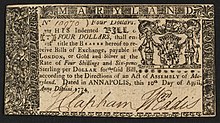
The pound (later dollar) was the currency of Maryland from 1733 until its gradual replacement with the Continental currency and later the United States dollar between the American Revolution and the early 1800s.[1][2] Initially, sterling coin circulated along with foreign coins. From 1733, this was supplemented by paper money, known as "Proclamation Money", denominated in £sd, but worth less than sterling, with 1 Maryland shilling (12 pence) = 9 pence sterling. A second "New" issue of notes was introduced in 1751, replacing the earlier notes at a rate of 1 New shilling = 1¼ Proclamation shillings.
The first issues of Continental currency in Maryland were denominated in £sd and Spanish dollars at a rate of 1 dollar = 4 shillings 6 pence. In 1780 two types of continental currency were issued, one valuing the Spanish dollar at 4 shillings 6 pence (printed in red ink and known as "Red Money"), the other (printed in black ink and known as "Black Money") valuing the Spanish dollar at 7 shillings 6 pence.
References[edit]
- ^ "Money in the American Colonies". eh.net. Retrieved June 7, 2020.
- ^ "Maryland State Archives - Guide to Government Records". guide.msa.maryland.gov. Retrieved June 7, 2020.
Well, that’s interesting to know that Psilotum nudum are known as whisk ferns. Psilotum nudum is the commoner species of the two. While the P. flaccidum is a rare species and is found in the tropical islands. Both the species are usually epiphytic in habit and grow upon tree ferns. These species may also be terrestrial and grow in humus or in the crevices of the rocks.
View the detailed Guide of Psilotum nudum: Detailed Study Of Psilotum Nudum (Whisk Fern), Classification, Anatomy, Reproduction